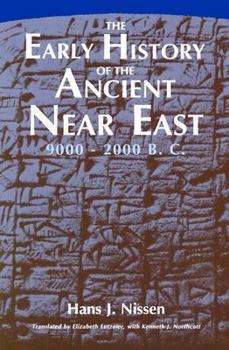The Early History of the Ancient Near East, 9000-2000 B.C.
Select Format
Select Condition 
Book Overview
Hans J. Nissen here provides a much-needed overview of 7000 years of development in the ancient Near East from the beginning of settled life to the formation of the first regional states. His approach to the study of Mesopotamian civilization differs markedly from conventional orientations, which impose a sharp division between prehistoric and historic, literate, periods. Nissen argues that this approach is too rigid to explain the actual development...
Format:Paperback
Language:English
ISBN:0226586588
ISBN13:9780226586588
Release Date:May 1990
Publisher:University of Chicago Press
Length:224 Pages
Weight:0.89 lbs.
Dimensions:0.6" x 6.0" x 9.0"
Related Subjects
Ancient Archaeology History Politics & Social Sciences Social Science Social SciencesCustomer Reviews
3 ratings
History between Atlantis and Egypt.
Published by Thriftbooks.com User , 15 years ago
I expected a little more of this book than what I got. Much of the archeological material leans on pot sherd findings and interpretations, something I am not too familiar with. I would think a people who possibly came from a more enlightened source would leave material that was further advanced in information than pottery shreds. It was very scientific with a few personal observations scattered through the rather brief book that was presented. It does help, even if in a small way, in defining this time line of life of late Atlantans and early Egyptians. I would like to know more about this time era from other sources. Can anyone point me in the proper direction wherein further material will pull my hair out??
Great read
Published by Thriftbooks.com User , 17 years ago
You don't have to be in an Archeology class (like me) to appreciate this book. It is a quick-reader full of well flowing information. Its not too technical though, so its great for those with minor understandings of the period, or the field of study in general. So many people focus on Ancient Egypt or Babylon, but what about BEFORE then. Its an increadibley important time period, and what sorts of things happened may surprise you!!
Difficult to read, but well worth the effort
Published by Thriftbooks.com User , 19 years ago
I bought this book along with two others because of a major gap in my knowledge in the period of Mesopotamia before the 1st Dynasty of Babylon, and because I wanted to have much better understanding of how the earliest civilizations developed from the simple humble settlements. This book provides and excellent and detailed review of the subject. The author, Hans J Nissen, describes the development of the early settlements in ancient Mesopotamia, and the reasons why it was here rather than elsewhere in the ancient Near East that these settlements first became City States, and then into the larger regional and national states of Sargon of Akkad and the 1st Babylonian dynasty of which Hammurabi is the best known ruler. The reason, according to Nissen, is the dramatic effect of climate change in Mesopotamia during the second half of the third millennium BC, and the need for inter-community cooperation. As the effects became more threatening and pervasive, (along with a change in the course of the Euphrates River) increased competition between cities changed this from a voluntary co-operation to one which was compulsory. Hence the development of organised labour to build canals and other infrastructures in order to maintain the basic amenities for survival, as well as for ensuring the continuation of trade which was particularly important for the acquisition of natural resources which are generally not locally available in Mesopotamia.There is very little speculative opinion in this book and Nissen is very careful to identify what are the limits of our knowledge, and what we can interpret from the archaeological record. His approach is to identify what has been found, what can be deduced from the findings. He is very firm in explaining what should not be deduced and the reasons why..The time frame, as the title indicates, is for the period 9000-2000BC, with a focus on the earliest Mesopotamian states, and most specifically Babylonia which was the area most affected by the climate change. This includes a thorough description and analysis of their relationships with their immediate neighbours to the west and north in Syria, Anatolia, and Kurdistan, as well as those with the regions of Elam, and the Zagros Mountains of Iran to the east. Nissen uses the generally accepted chronology, which is no great relevance in view of the general theme of his book.The book is well structured in six chapters: 1: Sources and Problems2: The Time of Settlement c 9000-6000BC (Neololithic, Hassuna, Halaf periods) 3: From Isolated Settlement to Town c 6000-3200BC (Ubaid and early Uruk periods) 4: Early High civilization c 3200-2800BC (Late Uruk, Jamdet Nasr, Early Dynastic I periods) 5: Rival City States c 2800-2350BC (Historical - Early Dynastic 2, 3 periods) 6: First Territorial States c 2350-2000BC (Akkad & immediate post-Akkad period)There are some 70 charts, diagrams, illustrations, photographs, and maps which are of great h





